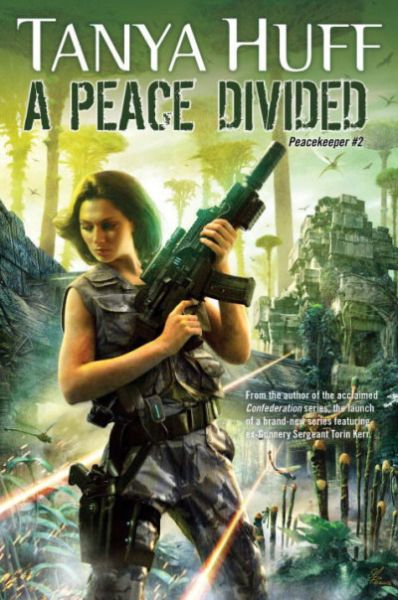Peacekeeper, Take Your Time
A Peace Divided (Peacekeeper, volume 2)
By Tanya Huff

3 Jun, 2017
Military Speculative Fiction That Doesn't Suck
0 comments
2017’s A Peace Divided is the second novel in Tanya Huff’s Peacekeeper series.
War’s end means that many former soldiers are dumped back into civilian life. Not all of the veterans are suited to peacetime occupations. Some, like Gunnery Sergeant Torin Kerr and her team, find gainful employment as Wardens, the interstellar police of the Confederation. Less fortunate cast-offs, like Commander Yurrisk and his soldiers, become bandits and mercenaries.
33X73’s natives vanished long before the Confederation was formed. Even at their height, they never got close to star-flight or Elder-Race-level technology. Why then did Yurrisk’s mercenaries attack and occupy an archaeological dig on 33X73?
The fact that the attackers are drawn from both Confederation and Primacy forces is a clue. Though rivals, the two polities do have a mutual enemy: the so-called plastic aliens. 33X73 offers a unique opportunity to hit back at the enemy.
The remnants of a plastic alien found in an ancient latrine on 33X73 suggest that somehow one of them died on 33X73. It seems unlikely that the low-tech natives managed to kill at least one of the incredibly durable aliens. What weapon could they have used? If it was one that they made, how did they do so? The slight chance that there was such a weapon and that it survived the destruction of its creators is enough reason for the mercenary incursion.
And if Arniz, Ganes, and the other archaeologists on 33X73 plead ignorance of the location and even the nature of the weapon? No problem. The invaders will simply shoot the recalcitrant scientists one by one until someone hands over the device. Since the archaeologists are as ignorant of the nature and location of the hypothetical weapon as they claim to be, the odds are very good that their captors will run out of scientists to shoot before they get their hands on any weapon.
At least, they will if Kerr and her team don’t manage to rescue the scientists first.
~oOo~
Both of the books in this series have involved archaeological expeditions that turned out badly. I wonder if the third will as well? I wonder if there is a market for “Archaeology: Just Don’t” t‑shirts in the Confederation? But Huff is not simply reprising the first book here. An Ancient Peace was a caper novel; this is a rescue mission. Presumably the third novel will be still a third genre. [Editor’s note: romantic comedy? ]
The Confederation setting has, as a fair number of SF settings do, something of a Fermi Paradox issue. A surprising number of species have all developed advanced technology at about the same time. This synchronization occurs between unrelated species across interstellar distances, in shorter time periods than it took Earth-bound humans to share tech across a few thousand kilometres. Part way through this book, I started to suspect that it may not have been a coincidence that all these species went from Stone Age to starfaring just as a group of plastic aliens started using them as playing pieces in a game of interstellar intrigue. Have I divined something that the author is going to spring on us in the next volume? Or is it just that I am particularly good at spontaneous retconning?
What does seem to be clear: in this volume, we meet the power behind Humans First (formerly Human’s First). It seems reasonable this person will be the Big Bad for the remainder of the series. Drinks for everyone if I am wrong.
Just as the Confederation was inept at fighting wars (which is why they recruited the Younger Races as mercenaries) so too do they seem to be crap at dealing with the war’s human detritus. Yurrisk and his soldiers are for the most part not intentionally monstrous (the one exception is the casually homicidal Sergeant Martin). It’s just that they are so damaged by their experiences that they are unable to function in civilian life. The Confederation didn’t provide them with a post-war niche, giving the Big Bad an opportunity it did not pass up.
Readers looking for a story where simply killing everything on the other side is not an option— Flashpoint versus 24—will enjoy this. I should add that although the book is part of a series, A Peace Divided can be read as a standalone.
A Peace Divided is available here (Amazon) and here (Chapters-Indigo).
Please email corrections to jdnicoll at panix dot com.
